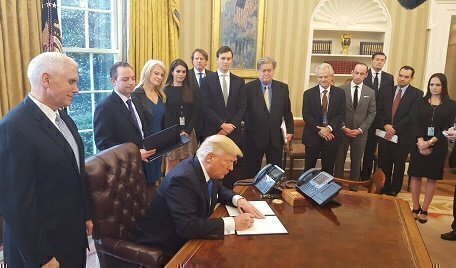The Supreme Court agreed on Friday afternoon to consider the state of Hawaii’s claim that President Trump imposed an unconstitutional “Muslim ban” when he ordered strict new limits on entry into the U.S. by foreign nationals from six nations with Muslim-majority populations. That constitutional question was added as the Justices also agreed to review whether the Trump order issued in September is illegal under federal immigration laws or federal procedural rules.
 The order came in response to an Administration appeal of a decision by lower courts that the President did not have the authority, under immigration law, to adopt a permanent restriction on entrance by individuals from Chad, Iran, Libya, Somalia, Syria and Yemen. The presidential order was the first version of the Administration’s effort to cut back on immigration on the argument that this was necessary to protect America from foreign terrorists.
The order came in response to an Administration appeal of a decision by lower courts that the President did not have the authority, under immigration law, to adopt a permanent restriction on entrance by individuals from Chad, Iran, Libya, Somalia, Syria and Yemen. The presidential order was the first version of the Administration’s effort to cut back on immigration on the argument that this was necessary to protect America from foreign terrorists.
When Adminisration lawyers first filed the current appeal to the Supreme Court, they argued that the Supreme Court need not decide any constitutional question because, they contended, the President clearly had the power to issue the order under authority granted by federal immigration laws.
When the main challenger in the case, the state of Hawaii, sent in its response, it urged the Justices to take on the question of whether the presidential order violated the Establishment Clause of the Constitution’s First Amendment, which bars the government from discriminating among religions. Hawaii and other challengers have argued repeatedly that President Trump, both during his campaign for the White House and since he took office has repeatedly moved to impose a “Muslim ban.”
While the Administration flatly disputes that claim, its lawyers urged the Supreme Court to add it to their review, after Hawaii had proposed it. The order issued Friday afternoon referred specifically to the constitutional question as proposed in Hawaii’s legal brief.
The order granting review did not specify when the case would be scheduled for a hearing before the Justices, but the government has suggested that the hearing should be held in April – the last scheduled set of hearings of the Court’s current term.
Although the Court had not agreed prior to Friday to consider the case, the Court in majority in December had granted the Administration’s request to allow it to put the presidential order into full effect, and that has been done since then.
The Trump order as originally issued also imposed restrictions on entry into this country from North Korea and of some government officials in Venezuela, but the state of Hawaii and other challengers had not contested the inclusion of those nations, so that part of the order will not be reviewed by the Justices.
By accepting review at this point in the Court’s term, the Justices gave themselves the opportunity to issue a final decision before the current term ends, probably in late June. Under the Court’s usual timetable, review almost had to be granted now in order for there to be enough time for lawyers to file briefs and for the Court to hold a hearing during the current term.
The Court’s agreement to hear the government’s new appeal came one day before the first anniversary of the Trump presidency. The President has been trying, since a few days after entering office, to craft an order that would accomplish the restrictions on immigration that he wanted from Mideast nations.
The first version was struck down by lower courts, and was then abandoned by the Administration when it adopted a second version. The second attempt was a temporary, but the Supreme Court had agreed to rule on its validity after lower courts concluded that it was likely to be struck down after full review in court was completed.
However, the Court never had a chance to rule on the second version, because it was abandoned by the Administration when it prepared a third, and permanent, version in September. That is the one now before the Court.
If the Justices were to rule that the presidential order exceeded the Chief Executive’s powers as defined by Congress, it may not reach the constitutional question of whether the order amounts to an unconstitutional “Muslim ban” – a restriction based on religious discrimination. If, however, the Justices were to rule that the President acted within his authority under federal immigration law, it then would probably feel that it had to decide whether the order was valid under the Constitution.
There is a possibility that the Court may not decide, in the end, the legality or constitutionality of the presidential order, because the first question the Administration’s appeal put before the Justice was whether the order was even subject to challenge in court.
From the beginning of the controversy over the entry restrictions, government lawyers have repeatedly argued that Congress has given the President exclusive authority to decide when to impose a ban on entry of any individual foreign national, or any group of such foreign travelers, and thus there is no role for the courts to play in reviewing such presidential initiatives.
So far, that argument has been rejected each time in the lower courts, but the Administration made that the first question in its new appeal. If the Justices were to accept that claim, the case would be ended with no ruling on any other issue.
The second of three questions posed in the Administration appeal is whether the order’s terms, as issued in September, were legal under existing presidential power over immigration. The third question is whether the lower court order temporarily blocking enforcement of the Trump order should not have been nationwide, but at most should have been limited to barring enforcement as to those individuals or entities that filed the lawsuit against the order.
The ban on enforcement as originally issued by U.S. District Judge Derrick K. Watson of Honolulu temporary barred enforcement nationwide, as to any foreign nationals from any of the six Muslim-majority nations involved in the lawsuit. The Ninth Circuit Court upheld the enforcement bar, but said it would only apply to foreign travelers from the six nations if those individuals did not have a close family or institutional tie to the U.S. Even that enforcement bar was lifted when the Justices allowed the Administration temporarily to go forward with all of the presidential restrictions.
When the Justices took on the controversy on Friday, they picked up from Hawaii’s brief the fourth question to be reviewed: does the presidential order violate the Constitution's ban on religious discrimination.
At times as the lawsuits against the Trump initiatives have unfolded in the lower courts, there have been temporary rulings that the presidential order would likely be found to be an unconstitutional “Muslim ban.”
That specific question is among the issues now under review in a case that began in Maryland, but is now awaiting a decision by the U.S. Court of Appeals for the Fourth Circuit. The Circuit Court held a hearing on that case on December 8, but as of Friday afternoon, there was no decision from that court. That will not affect the Justices’ review of the Hawaii case, because that review will now cover all of the same issues that are at stake in the Maryland case.






